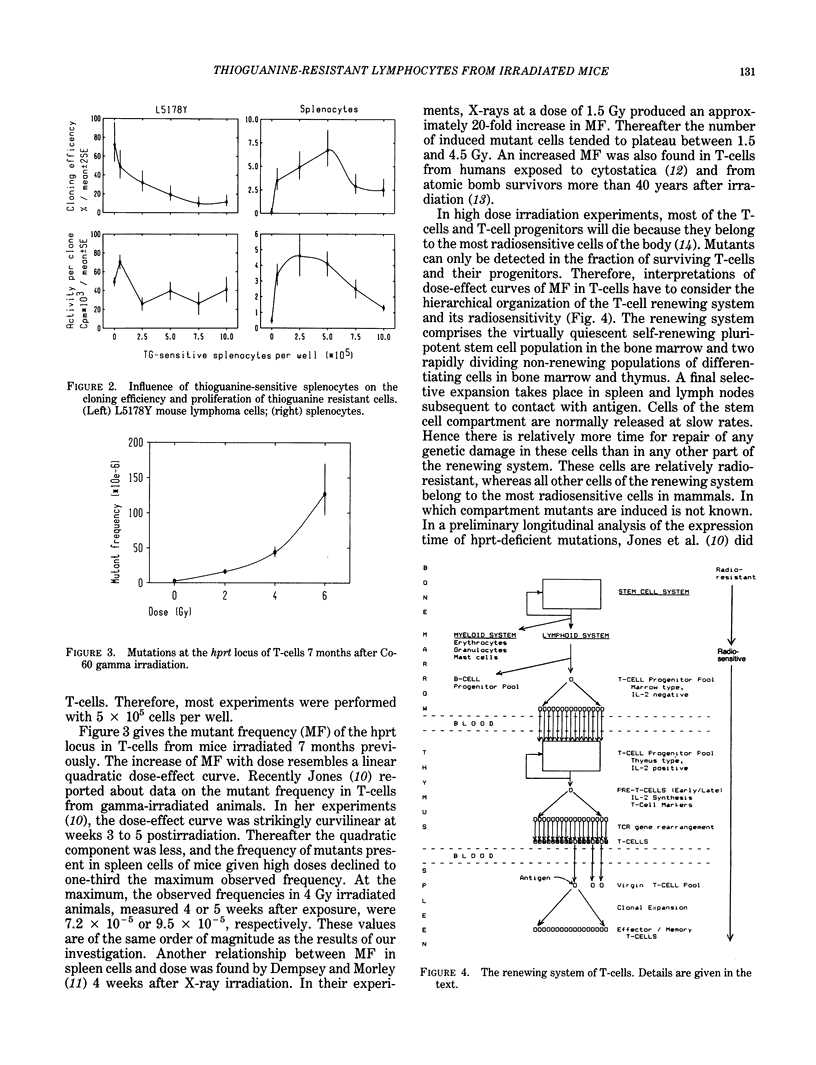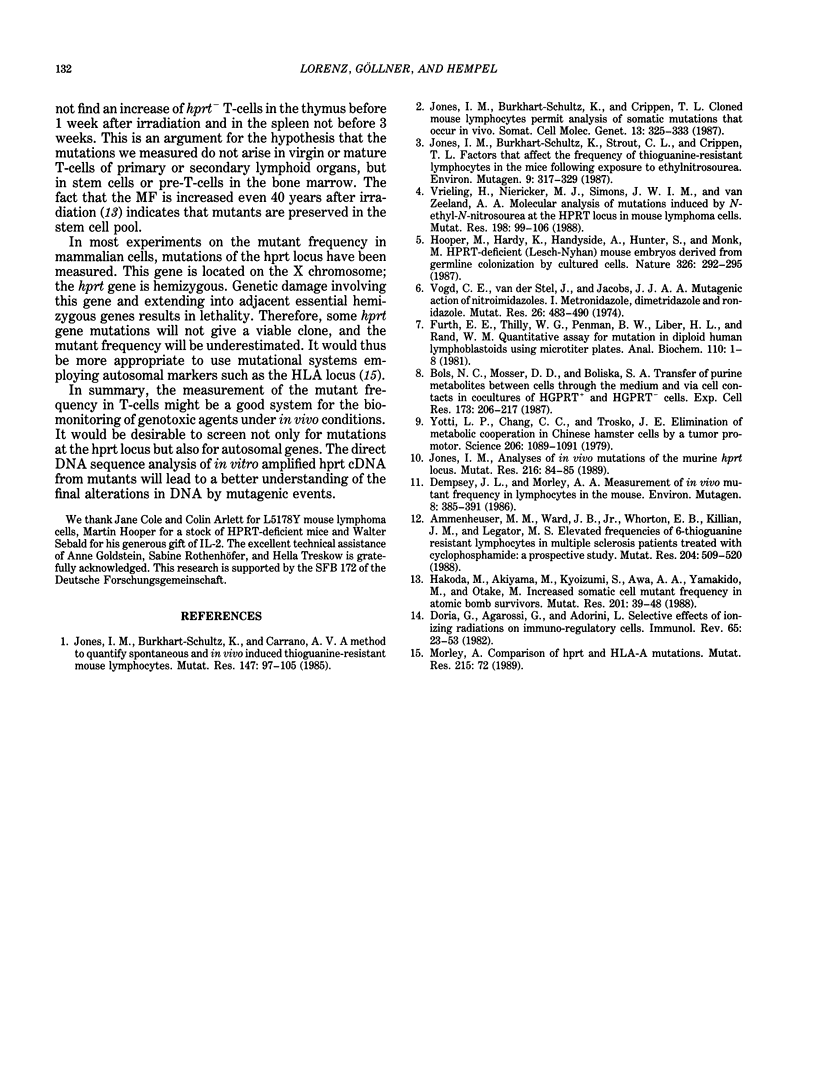Abstract
Adult mice were Co-60 gamma irradiated, and 7 months later splenocytes were isolated, cultured in microwells, and the frequency of hprt-deficient mutants was determined by measuring the cloning efficiency in media with 6-thioguanine. The mutant frequency at 2, 4, and 6 Gy was 1.6 x 10(-5), 4.4 x 10(-5), and 12.7 x 10(-5), respectively. The frequency of spontaneous mutants was 2.5 x 10(-6). The effect of metabolic cooperation on the cloning efficiency of thioguanine-resistant T-cells in selective medium was evaluated in co-cultures with wild-type T-cells. We found that the growth of hprt-deficient T-cells is supported in the presence of thioguanine-inactivated wild-type splenocytes up to a cell density of 5 x 10(5) cells per well. When cell density was higher, cell growth was inhibited. Possibilities and limitations of cloned lymphocytes for the analysis of somatic mutations that occur in vivo are discussed.
Full text
PDF



Selected References
These references are in PubMed. This may not be the complete list of references from this article.
- Ammenheuser M. M., Ward J. B., Jr, Whorton E. B., Jr, Killian J. M., Legator M. S. Elevated frequencies of 6-thioguanine-resistant lymphocytes in multiple sclerosis patients treated with cyclophosphamide: a prospective study. Mutat Res. 1988 Mar;204(3):509–520. doi: 10.1016/0165-1218(88)90045-6. [DOI] [PubMed] [Google Scholar]
- Bols N. C., Mosser D. D., Boliska S. A. Transfer of purine metabolites between cells through the medium and via cell contacts in cocultures of HGPRT+ and HGPRT- cells. Exp Cell Res. 1987 Nov;173(1):206–217. doi: 10.1016/0014-4827(87)90346-6. [DOI] [PubMed] [Google Scholar]
- Dempsey J. L., Morley A. A. Measurement of in vivo mutant frequency in lymphocytes in the mouse. Environ Mutagen. 1986;8(3):385–391. doi: 10.1002/em.2860080307. [DOI] [PubMed] [Google Scholar]
- Furth E. E., Thilly W. G., Penman B. W., Liber H. L., Rand W. M. Quantitative assay for mutation in diploid human lymphoblasts using microtiter plates. Anal Biochem. 1981 Jan 1;110(1):1–8. doi: 10.1016/0003-2697(81)90103-2. [DOI] [PubMed] [Google Scholar]
- Hakoda M., Akiyama M., Kyoizumi S., Awa A. A., Yamakido M., Otake M. Increased somatic cell mutant frequency in atomic bomb survivors. Mutat Res. 1988 Sep;201(1):39–48. doi: 10.1016/0027-5107(88)90109-1. [DOI] [PubMed] [Google Scholar]
- Hooper M., Hardy K., Handyside A., Hunter S., Monk M. HPRT-deficient (Lesch-Nyhan) mouse embryos derived from germline colonization by cultured cells. Nature. 1987 Mar 19;326(6110):292–295. doi: 10.1038/326292a0. [DOI] [PubMed] [Google Scholar]
- Jones I. M., Burkhart-Schultz K., Carrano A. V. A method to quantify spontaneous and in vivo induced thioguanine-resistant mouse lymphocytes. Mutat Res. 1985 Jun;147(3):97–105. doi: 10.1016/0165-1161(85)90022-6. [DOI] [PubMed] [Google Scholar]
- Jones I. M., Burkhart-Schultz K., Crippen T. L. Cloned mouse lymphocytes permit analysis of somatic mutations that occur in vivo. Somat Cell Mol Genet. 1987 Jul;13(4):325–333. doi: 10.1007/BF01534926. [DOI] [PubMed] [Google Scholar]
- Jones I. M., Burkhart-Schultz K., Strout C. L., Crippen T. L. Factors that affect the frequency of thioguanine-resistant lymphocytes in mice following exposure to ethylnitrosourea. Environ Mutagen. 1987;9(3):317–329. doi: 10.1002/em.2860090311. [DOI] [PubMed] [Google Scholar]
- Voogd C. E., Van der Stel J. J., Jacobs J. J. The mutagenic action of nitroimidazoles. I. Metronidazole, nimorazole, dimetridazole and ronidazole. Mutat Res. 1974 Dec;26(6):483–490. doi: 10.1016/s0027-5107(74)80049-7. [DOI] [PubMed] [Google Scholar]
- Vrieling H., Niericker M. J., Simons J. W., van Zeeland A. A. Molecular analysis of mutations induced by N-ethyl-N-nitrosourea at the HPRT locus in mouse lymphoma cells. Mutat Res. 1988 Mar;198(1):99–106. doi: 10.1016/0027-5107(88)90045-0. [DOI] [PubMed] [Google Scholar]
- Yotti L. P., Chang C. C., Trosko J. E. Elimination of metabolic cooperation in Chinese hamster cells by a tumor promoter. Science. 1979 Nov 30;206(4422):1089–1091. doi: 10.1126/science.493994. [DOI] [PubMed] [Google Scholar]


